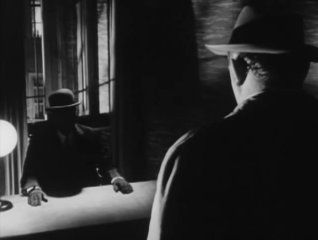Whoever looks for me will find death.


Since Fritz Lang was courteous enough to revive one of his most famous characters with 1960's The 1000 Eyes of Dr. Mabuse, it's only natural that others would keep the ball rolling for the next few years, especially with the concurrent krimi cycle in full swing. The first direct sequel, appropriately enough, was 1961's The Return of Dr. Mabuse, directed by Harald Reinl, late of The Fellowship of the Frog and The Terrible People. Co-written by Marc Behm (who later collaborated on the story for Charade and co-wrote the Beatles' Help!) and Ladislas Fodor (who worked on all of the subsequent Mabuse films as well as The Strangler of Blackmoor Castle and The Phantom of Soho), The Return of Dr. Mabuse opens with the requisite murder (in this case of a government agent who gets pushed off a moving train by a man with a wooden leg) which puts the kibosh on Inspector Lohmann's planned fishing trip.
Previously played by Otto Wernicke (in 1933's The Testament of Dr. Mabuse) and now embodied by Gert Fröbe (who played a different police detective in The 1000 Eyes), Lohmann doggedly follows the baffling leads wherever they take him, even if it is to a criminal mastermind (again played by Wolfgang Preiss, returning from The 1000 Eyes) who's supposed to be dead. And speaking of death, there are some particularly nasty ones in this film, including a woman getting burned to a crisp by a truck-mounted flamethrower, a man getting driven into a wall by a truck, a man getting blown up in his car, and one (who died by throwing himself out a window) whose corpse is dissolved in acid, leaving nothing but the skeleton behind. One thing that can definitely be said about Dr. Mabuse's criminal organization (which is attempting to align itself with a Chicago-based syndicate and seeks to impress them by using zombified prison inmates under the influence of a synthetic narcotic to blow up an atomic power plant): it's usually very thorough.
In addition to Inspector Lohmann's, there are parallel investigations being carried out by FBI man Joe Como (Lex Barker), who may actually be syndicate intermediary Nick Scappio (or maybe it's the other way around), and intrepid lady reporter (is there any other kind?) Maria Sabrehm (Daliah Lavi), whose chemist father (Rudolf Forster) was arrested years before on trumped-up espionage charges and has been in prison ever since. There's also a great deal of intrigue surrounding prison warden Wolf (Fausto Tozzi), whose office is lined with plaster casts of "the leading criminals of the century," and his untrustworthy underling Böhmler (krimi fixture Werner Peters), whose cell block has something of an open-door policy. Then there's the benign-seeming Pastor Briefenstein (Rudolf Fernau), who tells Lohmann, "Every soul is immortal, Inspector, and the name of Mabuse is just a personification of criminality," and whose church is the site of the film's first death trap. (The other one is a replay of the two-lovers-locked-in-a-room-that-gets-flooded-with-water scenario that is one of Dr. Mabuse's standards, apparently.)
Of special interest to me is the fact that when he is shown (first on a television monitor, later in closer quarters), Dr. Mabuse is a blank whose face is hidden by deep shadows or otherwise obscured. And when he's finally confronted by Lohmann, not only is the lower half of his face covered up like he's some sort of a bandit, but it's further revealed that he's wearing a rubber mask and has been impersonating another character all along. More than anything, that reinforces the notion that Dr. Mabuse could be virtually anyone, which Behm and Fodor underline by having Lohmann openly wonder whether Mabuse is still out there somewhere, planning his next caper. Considering there were four more entries in the series to come, I'd say the answer to that question is a resounding yes.